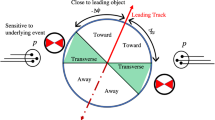Abstract
Underlying events dominate most of the hadronic activity in p–p collisions and are spanned from perturbative to non-perturbative quantum chromodynamics (QCD), with sensitivity ranging from multi-scale to very low-x-scale physics. A detailed understanding of such events plays a crucial role in the accurate understanding of Standard Model (SM) and beyond Standard Model physics. The underlying event activity has been studied within the framework of the Pythia 8 Monte Carlo model, considering the underlying event observables mean charged particle multiplicity density (\(\langle d^{2}N /d\eta d\phi \rangle \)) and mean scalar \(p_T\) sum (\(\langle d^{2} \sum p_{T} /d\eta d\phi \rangle \)) as a function of the leading charged particle in the towards, away, and transverse regions of p–p collisions at \(\sqrt{s}\) = 2.76, 7, and 13 TeV. The towards, away, and transverse regions have been defined on an azimuthal plane relative to the leading particle in p–p collisions. The energy dependence of underlying events and their activity in the central and forward regions have also been studied. The effect of hadronic re-scattering, color reconnection, and rope hadronization mechanism implemented in Pythia 8 has been studied in detail to gain insight into the different processes contributing to underlying events in the soft sector.















Similar content being viewed by others
Data Availability Statement
This manuscript has associated data in a data repository. [Authors’ comment: The plots shown are results of the simulation carried out at private cluster. The published data points are taken from Reference [13].]
References
G. Aad et al., ATLAS Collaboration. Phys. Rev. D 83, 112001 (2011)
Rick Field, Annu. Rev. Nuclear and Particle Science 62, 453–483 (2012)
V. Khachatrayan et al., CMS collaboration. Eur. Phys. J. C 76, 155 (2016)
B. Abelev et al., ALICE Collaboration. JHEP 2012, 116 (2012)
S. Chatrchyan et al., CMS Collaboration. JHEP 2013, 72 (2013)
Torbjörn Sjöstrand, Stefan Ask, Jesper R Christiansen, Richard Corke, Nishita Desai, Philip Ilten, Stephen Mrenna, Stefan Prestel, Christine O Rasmussen, and Peter Z Skands. Comput. phys. commun. 191, 159–177 (2015)
R. Brun, F. Rademakers, Nucl. Instrum. Meth. A 389, 81–86 (1997)
Torbjörn Sjöstrand, Marius Utheim, Eur. Phys. J. C 80, 907 (2020)
J.R. Christiansen, P.Z. Skands, JHEP1508(2015)
C. Bierlich, J.R. Christiansen, Phys. Rev. D 92, 094010 (2015)
T.S. Biro, H.B. Nielson, J. Knoll, Nucl. Phys. B 245, 449 (1984)
C. Bierlich, G. Gustafson, L. Lonnblad, A. Tarasov, JHEP 2015, 148 (2015)
M. Aaboud et al., ATLAS Collaboration. JHEP 03, 157 (2017)
T. Aaltonen et al., CDF Collaboration. Phys. Rev. D 92, 092009 (2015)
Ortiz. Antonio, Palomo. Lizardo Valencia,Phys. Rev. D 96, 114019 (2017)
Ortiz. Antonio, Palomo. Lizardo Valencia, Phys. Rev. D 99, 034027 (2019)
J. Bellm, Eur. Phys. J C 76(4), 196 (2016)
C.B. Duncan, P. Kirchgaeer, Eur. Phys. J C 79, 61 (2019)
E. Bothmann et al., SciPost Phys. 7, 034 (2019)
Acknowledgements
The authors would like to thank the Department of Science and Technology (DST), India, for supporting the present work.
Author information
Authors and Affiliations
Corresponding author
Additional information
Communicated by Xin-Nian Wang.
Rights and permissions
Springer Nature or its licensor holds exclusive rights to this article under a publishing agreement with the author(s) or other rightsholder(s); author self-archiving of the accepted manuscript version of this article is solely governed by the terms of such publishing agreement and applicable law.
Springer Nature or its licensor holds exclusive rights to this article under a publishing agreement with the author(s) or other rightsholder(s); author self-archiving of the accepted manuscript version of this article is solely governed by the terms of such publishing agreement and applicable law.
About this article
Cite this article
Kumar, K., Dash, S. Effect of color reconnection and hadronic re-scattering on underlying events in p–p collisions at LHC energies. Eur. Phys. J. A 58, 148 (2022). https://doi.org/10.1140/epja/s10050-022-00795-7
Received:
Accepted:
Published:
DOI: https://doi.org/10.1140/epja/s10050-022-00795-7




